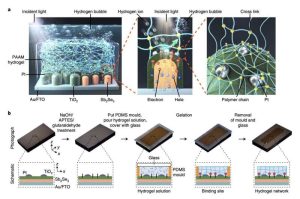
In recent years, engineers have been trying to devise new technologies to produce and store energy more sustainably, with the hope of overcoming the global reliance on fossil fuels and to fight climate change. A solution that has attracted much attention is the conversion of solar energy into hydrogen through a process known as water splitting.
Water splitting is a chemical process through which water can be broken down into its two main components: hydrogen and oxygen. Photoelectrochemical (PEC) water splitting processes would enable the production of green hydrogen from sunlight and water.
To be implemented on a large-scale, PEC devices should not be too expensive and should have a long lifetime. Developing devices that are stable over time using widely available and affordable materials, however, has so far proved challenging.
In fact, past studies have showed that photoelectrodes made of materials that are plentiful on Earth, such as light-absorbing semiconductors, tend to corrode easily when they are exposed to sunlight. This significantly hinders the development of PEC devices based on these abundant and more affordable materials.
Researchers at Yonsei University have recently introduced a new strategy that could increase the stability of photoelectrodes in PEC water-splitting devices. This method, introduced in a paper published in Nature Energy, entails the use of a hydrogel-based and transparent layer that can protect photocathodes (i.e., negatively charged electrodes that emit electrons when exposed to radiant energy light).
“The lifetime of photoelectrochemical devices is hampered by the severe photocorrosion of semiconductors and instability of photocatalysts,” Jeiwan Tan and his colleagues wrote in their paper. “We report a strategy for stabilizing photoelectrochemical devices that uses a polyacrylamide hydrogel as a highly permeable and transparent device-on-top protector.”
The permeable and transparent protective layer designed by Tan and his colleagues draws inspiration from photosynthetic marine plants. These plants, including seaweed, have cells that are covered in a nano-porous and protective hydrogel. This hydrogen can prevent the deformation and rupture of the cells that may result from physical contact with forces and organism in the aquatic environment.
When seaweed cells are coated with this hydrogen, they can transmit light and retain their water levels. The researchers tried to create a similar protective layer that could prevent the corrosion of photoelectrodes, thus enhancing the stability of PEC devices. They tested this layer on a photocathode made of antimony triselenide (Sb2Se3).
“A hydrogel-protected Sb2Se3 photocathode exhibits stability over 100 h, maintaining ~70% of the initial photocurrent, and the degradation rate gradually decreases to the saturation level,” the researchers wrote in their paper. “The structural stability of a Pt/TiO2/Sb2Se3 photocathode remains unchanged beyond this duration, and effective bubble escape is ensured through the micro gas tunnel formed in the hydrogel to achieve a mechanically stable protector.”
Initial tests carried out by the researchers yielded very promising results, suggesting that their protective hydrogen could prevent the degradation and corrosion of Sb2Se3-based photodetectors for water-splitting applications. Tan and his colleagues also showed that their hydrogel protector is compatible with electrolytes that have a broad range of pH values, while always using a SnS photocathode and a BiVO4 photoanode with a lifetime of ~500 hours.
In the future, the hydrogel-based protector introduced in their paper could be used to protect photocathodes inside various PEC devices for water-splitting. This could facilitate the large-scale implementation of these devices, ultimately helping to fight climate change.
